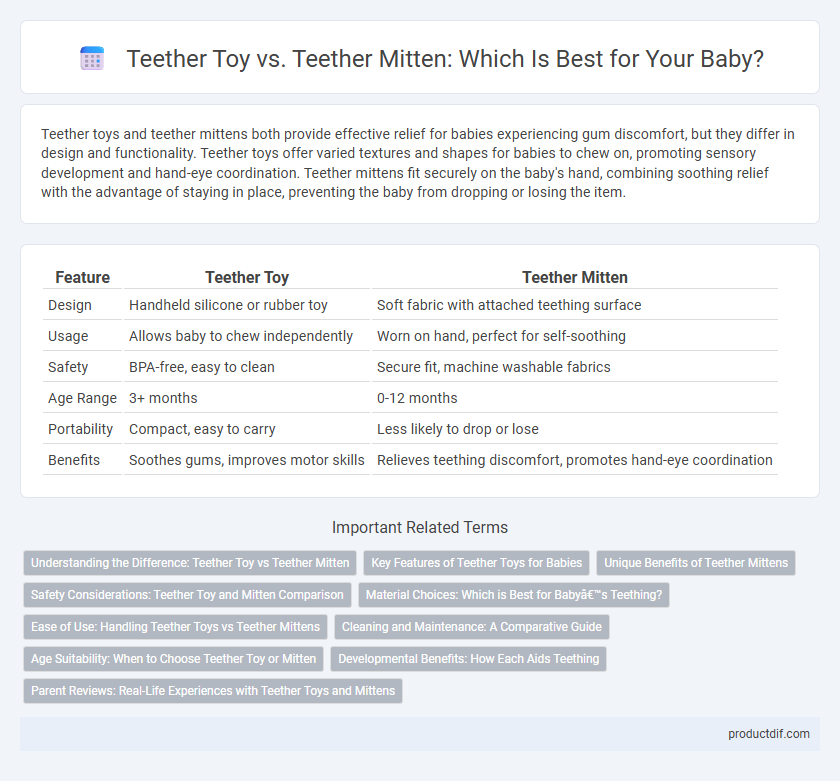Teether toys and teether mittens both provide effective relief for babies experiencing gum discomfort, but they differ in design and functionality. Teether toys offer varied textures and shapes for babies to chew on, promoting sensory development and hand-eye coordination. Teether mittens fit securely on the baby's hand, combining soothing relief with the advantage of staying in place, preventing the baby from dropping or losing the item.
Table of Comparison
| Feature | Teether Toy | Teether Mitten |
|---|---|---|
| Design | Handheld silicone or rubber toy | Soft fabric with attached teething surface |
| Usage | Allows baby to chew independently | Worn on hand, perfect for self-soothing |
| Safety | BPA-free, easy to clean | Secure fit, machine washable fabrics |
| Age Range | 3+ months | 0-12 months |
| Portability | Compact, easy to carry | Less likely to drop or lose |
| Benefits | Soothes gums, improves motor skills | Relieves teething discomfort, promotes hand-eye coordination |
Understanding the Difference: Teether Toy vs Teether Mitten
Teether toys and teether mittens both serve the purpose of soothing a baby's gums during teething but differ in design and usage. Teether toys are handheld objects made from safe materials that babies can chew on, promoting motor skills and relieving discomfort, while teether mittens are gloves with textured surfaces that babies wear, offering constant teething relief without the risk of dropping or losing the item. Choosing between them depends on the baby's stage of development and preferences, with mittens being ideal for younger infants who may not grasp toys yet and teethers better for more mobile babies.
Key Features of Teether Toys for Babies
Teether toys for babies are designed with soft, BPA-free silicone or rubber to soothe sore gums and promote oral development. Their ergonomic shapes and textured surfaces provide sensory stimulation while ensuring safe chewing for infants. Many teether toys also incorporate easy-to-grip handles and hypoallergenic materials to enhance comfort and hygiene during teething.
Unique Benefits of Teether Mittens
Teether mittens provide dual functionality by combining soothing teething relief with a wearable design that prevents babies from scratching their faces. The mitten's soft, textured silicone surface massages gums while offering easy grip and hands-free comfort, promoting independent self-soothing. Unlike traditional teether toys, these mittens stay securely on the baby's hand, reducing the risk of dropping and choking hazards.
Safety Considerations: Teether Toy and Mitten Comparison
Teether toys and teether mittens both provide safe options for soothing babies' gums, but their safety considerations differ significantly. Teether toys are typically made from non-toxic, BPA-free materials with textured surfaces to prevent choking hazards, while teether mittens combine soft fabric with a teething surface, reducing the risk of dropping and contamination. When choosing between the two, parents should consider the baby's age and hand coordination, as mittens minimize choking risks for infants who tend to grasp objects but may also require frequent cleaning to maintain hygiene.
Material Choices: Which is Best for Baby’s Teething?
Silicone and natural rubber are top material choices for teether toys due to their durability and safety, while teether mittens often combine soft fabrics like cotton with silicone teethers for dual sensory benefits. Medical-grade silicone is hypoallergenic and easy to clean, making it ideal for both teethers and mittens designed to soothe sore gums. Natural, non-toxic materials with BPA-free certifications ensure safety and comfort, crucial factors parents consider when selecting the best teething aid for their baby.
Ease of Use: Handling Teether Toys vs Teether Mittens
Teether toys offer varied shapes and sizes that can be easily grasped by older babies with improved hand coordination, while teether mittens are designed to slip onto an infant's hand, providing convenience for younger babies who lack strong grip strength. Teether mittens reduce the risk of dropping or losing the teether, making them practical for on-the-go soothing. In contrast, teether toys require more active handling, which can encourage fine motor skill development but may be less manageable for early teething stages.
Cleaning and Maintenance: A Comparative Guide
Teether toys often require thorough cleaning to remove residue from various textures, making dishwasher-safe options or easy-to-sanitize materials ideal for hygiene. Teether mittens provide the advantage of being machine washable along with baby's clothing, simplifying maintenance while ensuring consistent cleanliness. Both products demand regular cleaning to prevent bacteria buildup, but the mitten's fabric design typically offers more convenience for frequent washing and drying.
Age Suitability: When to Choose Teether Toy or Mitten
Teether toys are ideal for babies aged 3 to 12 months, providing varied textures to soothe emerging teeth and improve hand-eye coordination. Teether mittens suit younger infants around 0 to 6 months, offering a safe and wearable option that prevents the mitten from dropping while encouraging tactile exploration. Choosing between the two depends on the baby's motor skills development and age-related chewing needs to maximize comfort and safety.
Developmental Benefits: How Each Aids Teething
Teether toys promote fine motor skills by encouraging babies to grasp, chew, and explore different textures, aiding sensory development and soothing inflamed gums. Teether mittens combine comfort with mobility, allowing infants to self-soothe by chewing on a wearable surface that reduces the risk of dropping and increases tactile stimulation. Both options support oral-motor development but offer distinct sensory experiences that cater to varying stages of a baby's teething process.
Parent Reviews: Real-Life Experiences with Teether Toys and Mittens
Parents consistently highlight that teether toys provide targeted relief for sore gums with easy-to-grip designs, while teether mittens offer the convenience of being worn on the baby's hand, reducing choking hazards and encouraging self-soothing. Many reviews praise teether toys for varied textures that stimulate sensory development, whereas teethers mittens are favored for their portability and ability to stay clean during use. Overall, user experiences emphasize selecting based on the baby's age and chewing habits to maximize comfort and safety.
Teether toy vs Teether mitten Infographic

 productdif.com
productdif.com